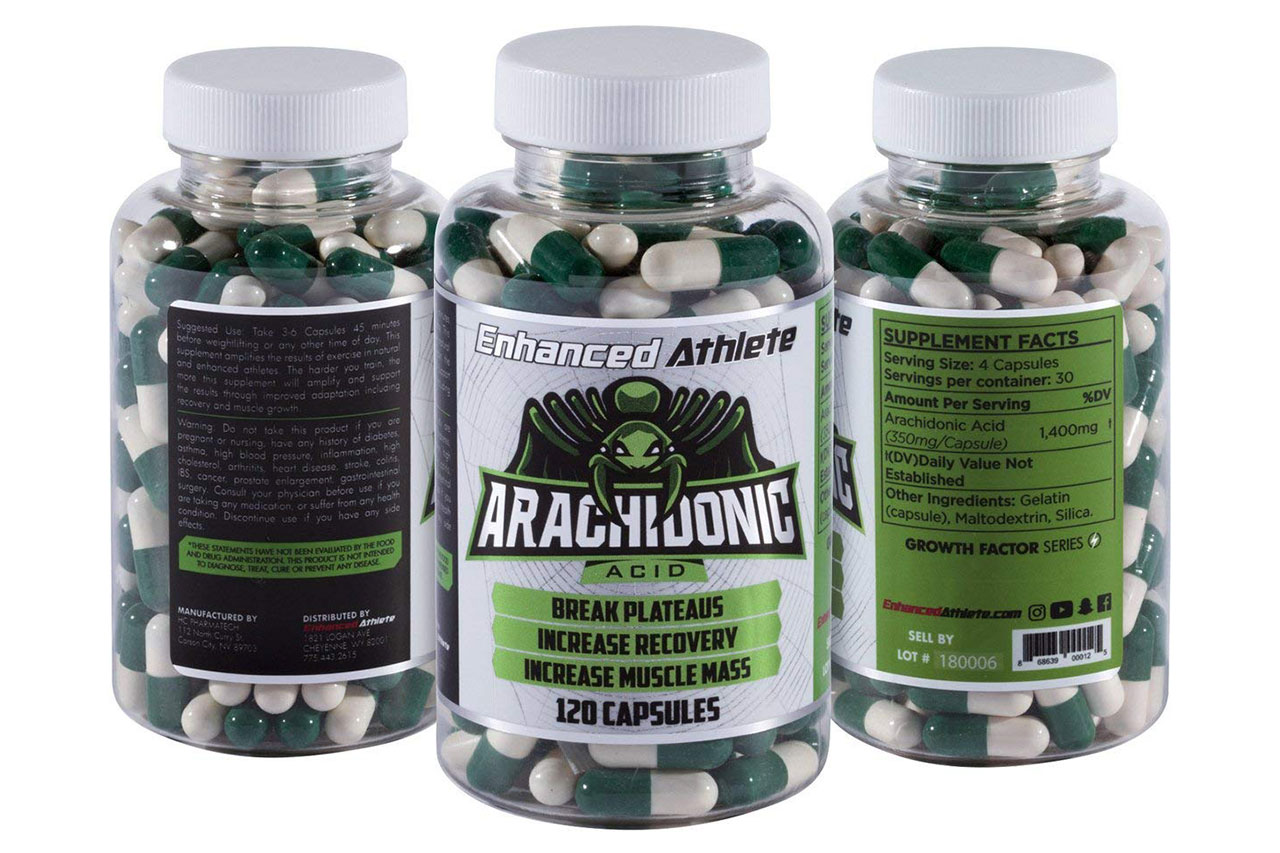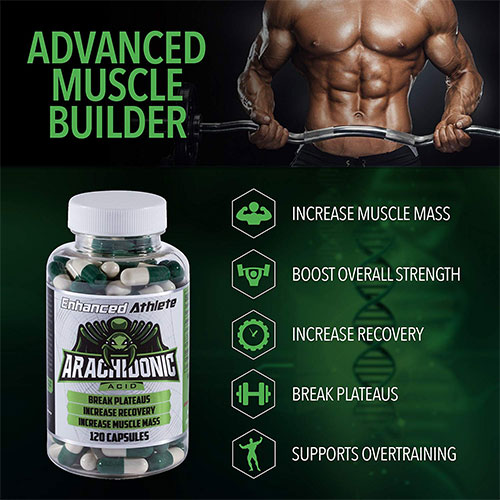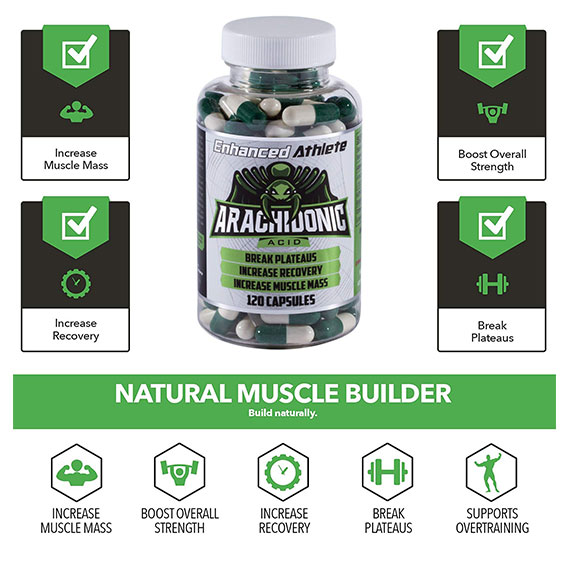This supplement is proven to be effective, as it benefits anaerobic metabolism and increases peak power generated by the muscles. This type of intense workload is specific to short burst requiring sports like crossfit and sprinting, along with all strength sports, where we have high energy consumption from big muscle chains, in short time intervals.
What is arachidonic acid?
Arachidonic acid (AA) is a polyunsaturated omega 6 fatty acid. It is found in the phospholipids called phosphatidyl-choline, phosphatidylethanolamine and phosphatidyl inositides. This group of substances is a natural part of the cell membranes and is found in liver, muscle and brain tissues of humans and animals.
What do you need to know about arachidonic acid?
At its core AA is a precursor of eicosanoids – signal molecules through which our body regulates inflammatory processes. Eicosanoid regulation is one of the most complex biochemical mechanisms of equilibrium in the human body and depends largely on the balance of omega 3 and omega 6 essential fatty acids in our food.
Apart from immunity, AA is associated with the inflammation and recovery process during heavy physical activity like weight lifting. Its presence is a key factor in the rapid recovery of muscle tissue, because it improves the membrane transport of substances for fast food for muscle cells.
This provides the basis for assumptions that AA is an essential regulator in the process of local muscle growth, which is what defines weight training. In brain tissue, AA is one of the most common fatty acids. Major roles known to perform within the brain tissue are:
- to impart fluidity (flexibility, reactivity) to the membranes of nerve tissue
- to stop all the free radicals that are still able to cross the blood-brain barrier
- to participate in the repair of the membranes of the nervous tissue
What is it used for and what health benefits does arachidonic acid have?
In addition to supplementing nutrition to ensure that the body is optimally functioning together with other essential fatty acids, AA is also taken on its own in several individual cases:
- in modulation of immunity
- as a strong antioxidant
- in combat with Alzheimer’s
- in combat with the manic-depressive disorder
- in the fight against certain cancers
- sports application
Specifically, in sports, the intake of AA is associated with a contribution to the following parameters from sports physiology:
- increasing the maximum realized power over time
- increase of the average realized power
- increasing maximum power
- increasing endurance
- reducing the levels of interleukin 6 (protein that regulates inflammation in the trained muscles)
How does arachidonic acid work in the body?
In general, arachidonic acid is a donor to produce compounds over long and complexly regulated chain reactions with several major variations in the production of eicosanoids. The arachidonic acid functions are more common in cell membranes, but also specific to the type of cell specialization and instantaneous status (rest, fatigue, fission).
After eating food, arachidonic acid begins to penetrate the body through the lining of the stomach and duodenum. Blood and lymph spread it to other tissues like other essential substances – amino acids, salts, glucose.
Once they have reached their final destination, AA molecules are involved in active synthesis of substances, according to today’s science, leading to some of the following proven / predicted benefits:
Proven Benefits in Humans:
Modulation of immunity – as its starting substance for eicosanoid synthesis, AA has a pro-inflammatory effect without itself stimulating an inflammatory effect. The body uses it in case of need.
High levels of AA are associated with low levels of interleukin 1 and interleukin 6 (signaling inflammatory proteins) and an increase in lymphotoxin alfa. Neuroprotective and antioxidant activity in the brain. Sports Benefits
- Some of the contributions are confirmed as positive, others as insignificant or none
- The anti-inflammatory properties of AA after exercise and its relationship to muscle anabolism via interleukin 6 have been confirmed. However, this does not in itself lead to statistically greater hypertrophy in the host.
- Weak or no response is seen in the parameters: strength, body composition, hypertrophy, hormones – catabolic and anabolic, aerobic endurance. This means that promoting AA as a unique factor for muscle growth has so far remained in the field of marketing, at least until reliable research has emerged.
Proven Benefits in Preliminary Studies with Cell Cultures and Laboratory Animals:
- Alzheimer’s disease – More research is needed to confirm the role of arachidonic acid to slow the onset of the disease and its side effects.
- Manic-depressive disorder – studies are at an early stage.
- Cancer treatment – here the information is conflicting. Some studies predict a positive role for AA, while others declare it a risk factor in autoimmune diseases.
Side effects of arachidonic acid
There are a number of studies demonstrating the good tolerability of AA. Studies in healthy young men for periods up to 50 days do not detect side effects of arachidonic acid intake. The same applies to children, pregnant women, nursing mothers and newborns under strict medical supervision.
There are, however, contraindications for AA, including a wide range of autoimmune diseases as well as diseases in which symptoms of chronic inflammation are present: allergy, arthritis, atherosclerosis, anemia, Alzheimer’s, heart failure, obesity, diabetes 1 and 2, myocardial infarction, digestive diseases – gastritis and ulcers, fibromyalgia, fibrosis, kidney failure, lupus, malignancies.
Who should take AA and what should it not be combined with?
In the presence of any of the above, do not take arachidonic acid. In case of chronic illnesses or ongoing inflammation, do not take AA except after consulting your GP. Uncontrolled intake of AA in pregnant women, nursing mothers, newborns and infants is not recommended.
Do not take arachidonic acid along with anti-inflammatory drugs such as aspirin, ibuprofen, acetaminophen. Otherwise you will reduce the role of AA on an immunomodulator. Taking other food supplements and foods with a pro-inflammatory effect may increase the properties of arachidonic acid.
These are the sources of omega 6 fatty acids, including corn oil, sunflower oil and sunflower seeds. Adoption of food and anti-inflammatory food supplements on the other hand will reduce the properties of arachidonic acid. These include: fish oil, rapeseed oil, concentrated omega 3 ECM, cold-blooded fish and fish by-products, sesame oil, sesame, peanuts, peanut butter. N-acetyl cysteine and bound linoleic acid.
What doses are recommended and how is it taken?
Studies on the effects of AA have been conducted at daily doses of 840 to 2000 mg / day for periods up to 50 days. The usual dose for sports supplementation is 1,000 mg per day with food. If it is a non-traditional use in combination with other substances, we recommend that you follow the instructions on the label of the product. Confirmed periods of safe intake are 50 days.
Which sports and health supplements can we meet and what are commonly contained with arachidonic acid supplements?
Arachidonic acid is a generic product that can be used alone in sport supplement formulas and, more rarely, in combination with other omega-6 and omega-3 EMCs in formula 3: 6 or 3: 6: 9 EMC. Unlike the omega 6 essential fatty acids, arachidonic acid is not found in food substitutes, enriched foods, and protein drinks / bars.
It seems that its production methodology makes it more expensive, so manufacturers do not include it there. The human body can produce AA from linoleic acid – the main omega 6 fatty acid, so the incorporation of AA in similar food and food supplements is considered unnecessary.
Self-arachidonic acid is often promoted as a growth factor, the absence of which is essential for muscular hypertrophy. More information about essential fatty acid relationships in the formulas can be read in these specialized articles:
MeanMuscles Recommendation: Enhanced Athlete Arachidonic Acid
Enhanced Athlete Arachidonic Acid
Muscle and Strength Booster Preserve Muscle and Boost Protein Synthesis – 350mg X 120 Capsules





